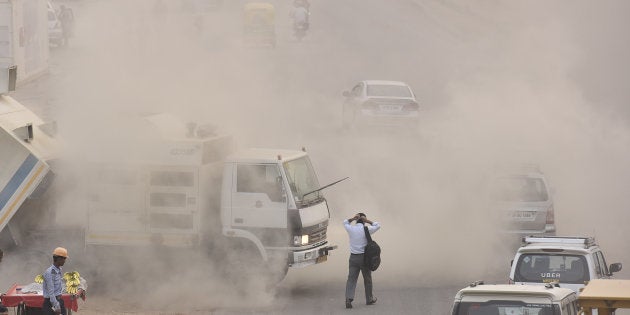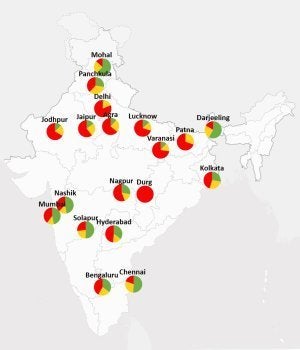
All across India, air quality plummets each autumn starting with the end of the monsoon season. Contributing factors include increased fuel burning, crop burning, and changing weather patterns. Then Diwali celebrations notoriously lead to spikes in air pollution, prompting bans on the sale of firecrackers this year in Delhi-NCR, with mixed results.
Air pollution consists of toxic gases and small, inhalable particles. Exposure to high levels of air pollution leads to acute and chronic diseases and even premature death. Particles 2.5 micrometres in diameter and smaller are also known as PM. These particles are the most likely to lead to negative health effects since larger particles cannot penetrate deeply into the lungs. For this reason, the level of PM in the air is the most useful metric for understanding the health impacts of particulate air pollution.
This figure shows a summary of measured PM data for September 2016-October 2017 for cities across India.

The pie charts show the number of days in the past year that the average PM level fell into the following three categories: Green days (PM< 35.4 μg m) are healthy or moderate, yellow days (35.5 μg mto 55.4 μg m) are unhealthy for sensitive groups such as children, the elderly or those with lung disease, and red days (PM> 55.5 μg m) is unhealthy for all. More details about the figure and data are available here.
The data show in concrete terms that Indians across the country are exposed to unhealthy air much of the year. Indeed, a 2017 report on the state of global air indicated that "...Bangladesh and India now have the highest exposures to PM, having experienced the steepest increases since 2010." Therefore, our results were not a surprise, however, these data for PM were not available in many locations until recently. Many more monitoring stations have come online in the past year. Some previous estimates of PMexposure in India were based on extrapolations from measurements of larger particles (e.g., PM), and can be improved now that additional PMdata are available.
Show me the data
The first step towards improving air quality is collecting reliable data and making it open and available, however, high-quality PM data are still not available for many locations across India, including entire states and major cities. India's Central Pollution Control Board (CPCB) conducts routine measurements of PMin some locations and established a national air quality index (AQI) in late 2014 as a simple means to communicate air quality data to the public. Collecting and maintaining data on emissions from pollution sources is a monumental task, and efforts by CPCB and local and state pollution control boards have been supplemented by university researchers and independent groups such as the U.S. diplomatic posts. Efforts by organisations like OpenAQ to aggregate and archive publicly available, ground-based data are important for analysis, and to help raise public awareness. Spatial and temporal resolution for air quality monitoring is improving, especially in the greater Delhi area, but more continuous monitoring coverage is needed across the country. Monitoring must eventually extend beyond the urban centres to understand the country-wide impact of air pollution.
The opinions expressed in this post are the personal views of the author. They do not necessarily reflect the views of HuffPost India. Any omissions or errors are the author's and HuffPost India does not assume any liability or responsibility for them.
